The past decade has seen a major shift in what it means to be an airman in the United States Air Force. At the same time, there has been a significant change in our understanding of what it takes to be a general officer.
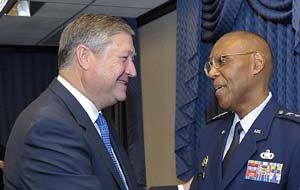 | ||
|
Secretary of the Air Force Michael Donley (l) congratulates Gen. Larry Spencer following the pinning on of his fourth star in July. (USAF photo by Michael J. Pausic) |
Even the post of Chief of Staff has been transformed. In August, Gen. Norton A. Schwartz wrapped up his four-year stint as USAF Chief of Staff. He was the first uniformed leader who was neither a fighter nor bomber pilot. He came from the special operations and mobility fields.
Take a look at the generals who wear four stars on their USAF uniforms. Often in years past, four-star officers at the Air Force’s highest Corona conclaves were fighter pilots all. Now, the group portrait of USAF four-stars looks quite different.
“The general makeup of Corona four-star meetings is changing and that’s not a bad thing for the Air Force,” said retired Gen. Carrol H. Chandler, former commander of Pacific Air Forces and vice chief of staff.
He’s right about the change. Today, the Corona membership comprises not only fighter pilots but also officers drawn from the mobility, bomber, space, acquisition, and financial management communities.
The group now includes the Air Force’s first female four-star, Gen. Janet C. Wolfenbarger, head of Air Force Materiel Command at Wright-Patterson AFB, Ohio. The position of vice chief of staff is held by a nonrated officer, Gen. Larry O. Spencer; he held the senior resource, budget, and planning post on the Joint Staff. For the first time in Air Force history, two African-Americans are holding four-star positions simultaneously.
Shaping the Cadre
The new look of USAF generals stems from changing demands on airpower and new leadership requirements that are reshaping the cadre of some 300 Active Duty men and women wearing stars. They are being shaped by new trends in missions, geopolitics, and the country itself.
Trend No. 1 is the fact that “fighter generals” have been joined in quantity by senior officers from air mobility, space, special operations, and other career fields.
Tracking the data on generals has been an interesting way to analyze the Air Force since 1998, when then-Col. R. Michael Worden published his book, Rise of the Fighter Generals. He traced the shift in power away from generals who’d flown bombers in combat and toward career fighter pilots.
For Worden, the signature event occurred in 1982, when Gen. Charles A. Gabriel became the first pure fighter pilot appointed to be Chief of Staff. His selection was “the first in a continuous string of generals with fighter backgrounds as Air Force Chiefs of Staff,” Worden noted.
As Worden wrote, these fighter generals—strengthened by their combat experience in the Korean War and Vietnam War and time on Cold War alerts—reflected trends in Air Force technology and operations.
The string of fighter-pilot dominance lasted 26 years. Technically, it was broken when Schwartz became Chief in August 2008.
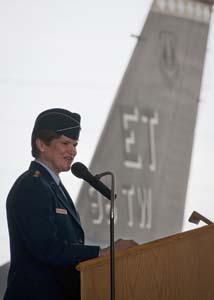
| ||
|
Gen. Janet Wolfenbarger speaks at a ceremony at Eglin AFB, Fla. Wolfenbarger, commander of Air Force Materiel Command, is USAF’s first female four-star general. (USAF photo by Samuel King Jr.) |
The impact of operations and technology has long been the primary force shaping USAF generals. “The Air Force, like all institutions, tends to draw senior leaders from the core mission of the organization, and that’s flying and fighting,” said RAND Corp. researcher Albert A. Robbert in a 2011 Stars and Stripes newspaper article.
Former Secretary of the Air Force Sheila E. Widnall pointed out that the qualities sought in a USAF general are shaped, in part, by USAF’s changing internal image as new technologies emerge. On a corporate scale, the institution seeks generals identified with the rising technology of the day.
Think back to Benjamin D. Foulois, Henry H. “Hap” Arnold, Billy Mitchell, Carl A. Spaatz, and their peers. The all-consuming task of keeping airplanes flying and arranging their missions into meaningful operations dominated. Their outstanding trait was mastery of aviation technology. The merge of technology and operations created the core identity of the Air Force. Brash and practical pilots led the Air Force for generations. Leaders got their schooling in the sky—if they survived.
“I became a leader the easy way,” recalled the legendary Brig. Gen. Robin Olds in a 1970 speech to cadets at the Air Force Academy. “I was one of the 40 young men that went over with a squadron in 1944 and joined the Eighth Air Force in fighters.”
Olds ended up as a squadron commander at age 22. As he half-jokingly recounted, “By the time we were completing our first tour, there were only eight of us left. That made it pretty easy for me.”
Here was the essence of Worden’s point about flying and operational experience. Time in fighters and sorties in Vietnam marked the leaders of the 1970s through the early 2000s.
The rise of expeditionary warfare in the 1990s and 2000s changed the type of pilot getting that heavy operational experience. New strategies flung airmen to Iraq, Bosnia, Kosovo, Afghanistan, the Horn of Africa, and beyond.
Mobility aviators were off to war on a continuous basis. Lt. Col. Laura L. Lenderman put it succinctly in her study of mobility generals published in 2008 by Air University. “Since the end of the Cold War,” she said, “airlift, air refueling, and aeromedical evacuation missions flown in support of combat and humanitarian operations have become an indispensable and direct aspect of US grand strategy.”
By the numbers, mobility missions grew to dominate sorties controlled by the air operations center for US Central Command. Lenderman found that mobility missions flown in support of wars in Afghanistan and Iraq from 2002 through April 2006 outnumbered fighter and bomber sorties by a ratio of two-to-one.
As with the fighter generals of the post-Vietnam era, the numbers soon turned into a leadership shift. Lenderman found that, in 1997, mobility generals filled just three of the 36 USAF three-star positions. Ten years later, they held 10 of the 40 three-star billets. That is a rise from 8.3 percent to 25 percent in a relatively short period.
By then, air mobility four-stars had begun to take senior commands outside their field. Gen. William J. Begert led Pacific Air Forces. Gen. Roger A. Brady commanded US Air Forces in Europe. Gen. Duncan J. McNabb became vice chief of staff.
Will the Air Force soon see general officers drawn from the newest tribes, such as operators of remotely piloted aircraft
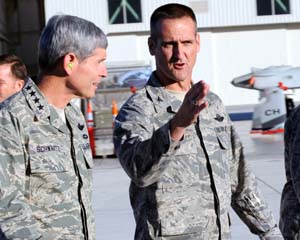
| ||
|
Then-Air Force Chief of Staff Gen. Norton Schwartz (l) speaks with then-Col. Peter Gersten at Creech AFB, Nev., in 2009. Gersten’s subsequent promotion to brigadier general from an RPA background indicates that USAF embraces new technologies as part of its service identity. (USAF photo by A1C Brett Clashman) |
“We already have one,” Chandler noted. He referred to Brig. Gen. Peter E. Gersten, who was promoted to one-star rank after commanding the 432nd Wing at Creech AFB, Nev. Gersten started his Air Force career as an F-16 pilot, including a squadron command, then acquired time flying the Predator, Reaper, and Sentinel RPAs at Creech.
This promotion from the RPA wing was no accident. It’s a sign the Air Force is embracing the new technology in its combat identity. Widnall described it as “sorting out the changing nature of what we’re doing” with airpower.
A Sea Change
Expeditionary operations produced more firsts. Of great significance was the assignment of a woman officer from the mobility world to be a joint force air component commander, or JFACC, in a major air campaign. She was Maj. Gen. Margaret H. Woodward, who led the coalition air campaign during the 2011 Operation Odyssey Dawn in Libya.
“Women have now participated in many more things throughout the Air Force than in the past,” said Chandler. “They are positioned to be at the four-star table.”
When Wolfenbarger took over Air Force Materiel Command this summer, Widnall, for one, was not surprised. “It’s gratifying,” she said—but hardly surprising. “I just assumed it would happen,” she said.
Widnall led the Air Force through a pioneering stretch as nearly all airmen’s jobs were opened up to women after Congress lifted the no-women ban on most USAF combat jobs.
One of the biggest steps was welcoming into the fold the Air Force’s first three female fighter pilots. The first to finish her qualifications and move on to fly the F-15E was Jeannie M. Flynn. “Being in the pilot corps does give additional opportunities,” Widnall said. Opening those careers to women made them “more of a complete part of the Air Force.”
Still, given the changes in the Air Force, fighter and bomber cockpits did not remain the only paths to the top. Wolfenbarger herself brought long experience in engineering, support, and program management. She’d already served as vice commander at AFMC. But she acknowledged the sea change.
“This opportunity only really exists because the Air Force has embraced a culture of diversity,” she said.
Today the one- and two-star ranks hold several rated women from the mobility forces. Women in total make up 18.8 percent of USAF officers and 19 percent of the enlisted force.
The Air Force has yet to see a female from a pure fighter or bomber background pin on her brigadier general’s star, but it seems inevitable. In June, Flynn—now Col. Jeannie M. Leavitt—took command of the 4th Fighter Wing at Seymour Johnson AFB, N.C.
Chandler observed that the general officers as a group have to provide a breadth of experience to the Air Force. “We need deep logistics experience that you may not have in a fighter pilot,” he said by way of example. “There aren’t enough years in a rated officer’s career to do all those things.”
The Air Force recently reached for financial and management experience in another significant promotion. Spencer, the new vice chief of staff, rose to his position in July from a background in budgets, finance, command of the 72nd Support Group, and serving as the Joint Staff’s J-8 as a three-star.
“What better time to have a vice chief with his background?” asked Chandler. “That’s an example of finding the officer the USAF needs.”
Tapping talent from nonrated career fields might well improve the overall skill set of the general officer pool, but it does not solve the long-standing problem of how to manage rated career paths to produce combat-oriented officers who can lead on the Air Staff and find their way into top joint jobs. It is difficult to take those officers with experience in operations and combat and give them the extra skills they need for the highest levels of command.
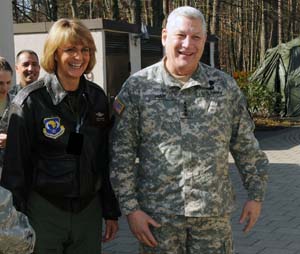
| ||
|
Maj. Gen. Margaret Woodward, then commander of Air Forces Africa, greets Gen. Carter Ham, head of US Africa Command, at Ramstein AB, Germany. Woodward became the first female to lead an air war when she led the coalition air campaign during Operation Odyssey Dawn in Libya. (USAF photo by SSgt. Stefanie Torres) |
The much-studied fighter pilots make a good example.
“If the fighter pilots are not getting the development in terms of experience in Joint Staffs and Air Staff and other places, … they’re not going to be sufficiently prepared to assume senior leadership roles in the future,” concluded Robbert from RAND.
The Air Force’s reliance on leaders who fly is a personnel headache. Flying, it turns out, takes lots of time. Pilots typically must gain 120 months—10 full years—of flying time in the first 18 years of their career, and wing command is the pinnacle. As a result, USAF brigadier generals form a pool characterized by “a heavy command focus and light experience in vital warfighting staff positions,” wrote USAF Maj. William H. Burks in a 2010 thesis for the US Army’s School of Advanced Military Studies at Fort Leavenworth, Kan.
He went on, “Something in the career path must change if the Air Force is going to grow future leaders more adept at strategic thinking and in the operational arts with the credentials to prove it.”
Pilots or otherwise, generals from the Air Force have not captured a proportionate share of coveted joint assignments. For all of the adaptation occurring within the Air Force, getting blue-suit generals into big joint jobs is still a struggle.
The historical record on theater command is dismal. No USAF officer has ever led US Pacific Command or US Central Command. Gen. Lauris Norstad and Gen. Joseph W. Ralston served as Supreme Allied Commander, Europe, but their stints came some 40 years apart. Gen. Douglas M. Fraser became only the third USAF officer to lead a geographic command with an area of responsibility outside the US when he assumed the post of US Southern Command in 2009. Two airmen have run NORAD and US Northern Command since NORTHCOM’s creation in 2002, but the post is now held by an Army general.
Current figures on who fills the top Joint Staff jobs tell another dismal story for the Air Force.
To begin with, only two of eight directors on the Joint Staff are Air Force generals. Lt. Gen. Brooks L. Bash was appointed in September 2011 to serve as director for logistics, J-4, and Lt. Gen. Mark F. Ramsay took over as director for force structure, resources, and assessment, J-8, in August. Both are pilots with long air mobility experience.
Meanwhile, the slate of nine combatant commanders includes Gen. William M. Fraser III at US Transportation Command and Gen. C. Robert Kehler at US Strategic Command.
Long and Delicate
No Air Force officers currently occupy the posts of JCS Chairman, JCS vice chairman, or director of the Joint Staff.
Of 21 high-profile Joint Staff or unified command jobs, only five are held by USAF officers. Clearly the much-reported one-third split between Army, Navy, and Air Force departments for budget resources doesn’t carry over into command jobs.
Grooming general officers to compete for jobs like these is a long process with delicate timing. It has to be done at a brisk pace, too, so that prospective three- and four-stars are nominated for jobs while they still have plenty of time left to serve and move to other assignments.
Meanwhile, the prospects also have to know people in the joint environment; simply having your name submitted is not enough for an appointment. Any big job usually has a handful of candidates from multiple services, all with stellar records.
Chandler described the task of grooming potential combatant commanders or JCS Chairmen as “a 25- to 30-year problem.” As officers move up, they “have to have the tools [they] need to become competitive down the road.”
An early step is ensuring the right kind of advanced educational opportunities for officers. In particular, high-powered master’s degrees and even the occasional doctorate lay the foundation for officers to obtain broader leadership opportunities and succeed when they get them.
Exposure to colleagues in other services, government branches, and industry also matters. For example, officers specializing in intelligence and cyberspace have to rotate through other parts of the national intelligence community as they advance. Relationships across Washington, D.C., can be an asset.
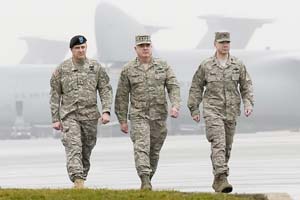
| ||
|
L-r: Army Brig. Gen. Kenneth Roberts, Gen. Carrol Chandler (now retired), and Col. Manson Morris return from a ceremony at Dover AFB, Del., in 2010. Chandler believes the changing makeup of the general officer roster is a good thing for the Air Force. (USAF photo by Jason Minto) |
A prime example of the right mix of flying, fighting, and career broadening is the new USAF Chief of Staff, Gen. Mark A. Welsh III. Welsh began his career flying A-10s in combat in Desert Storm. He commanded several operational units and served on the Joint Staff before taking the four-star job at USAFE, a post that pops up on the biographies of many a Chief of Staff. Before that came an unusual three-star assignment—at the CIA. Welsh was assigned the title of “Associate Director for Military Affairs” from August 2008 through December 2010. The job brought him into close contact with newly appointed director of the CIA, Leon E. Panetta, who then became Secretary of Defense in 2011 and had a hand in selecting Welsh for the top Air Force post.
That type of close contact is all to the Air Force’s benefit. A good sign for the Air Force’s future is the number of younger USAF generals holding deputy positions on the Joint Staff. Working on the staffs of combatant commanders also counts. “We need overseas experience,” said Chandler. “The exposure of being assigned overseas is going to become more and more important.”
Chandler believes the pilot experience will stay central to USAF leadership. “As far as I can see into the future, the Chief will most likely be a rated officer,” he acknowledged.
Even so, it seems clear that the monochrome days of the fighter generals aren’t coming back.
